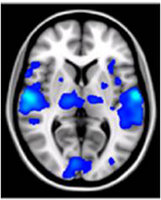News
How does the brain communicate?
On the way to the brain, nerve pathways in the human body cross each other. As a result, stimuli are processed in the opposite hemisphere of the brain. For example, if someone touches our right hand, the stimulus is received in the left half of the brain. To generate harmonious movement, both halves of the brain have to coordinate their activities. Neurochoice SystemsX researchers, Matthew Larkum and Lucy Palmer, recently published an article in Science which investigated the mechanisms of communication between the two cortical hemispheres in the brain. They used a range of methods such as intracellular measurements of single nerve cells in the cortex and various imaging techniques including optogenetics which allows brain cells to be controlled with light of a certain wavelength. Using these techniques, they found that stimulating the right and left paws of the rat generates a relatively slow, nearly half-second-long sustained inhibitory effect on neuronal activity. This interhemispheric inhibition was generated by interneurons in the top layers of the cortex that suppressed neuronal activity by activating particular inhibitory receptors (GABAB receptors) on neighbouring neurons. The results of this study shows that communication from one side of the brain to the other is extremely complicated and involves the precise recruit of a particular micronetwork of neurons within the brain. This sheds light on the consequences of brain damage to one side of the brain (by stroke or brain trauma) and also the intriguing case of hemi-neglect.
Reference: Palmer LM, Schulz JM, Murphy SC, Ledergerber D, Murayama M, Larkum ME. The cellular basis of GABA(B)-mediated interhemispheric inhibition. Science. 2012 Feb 24;335(6071):989-93

